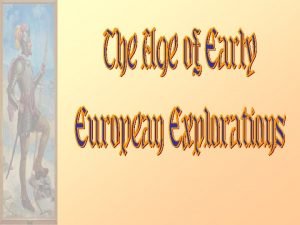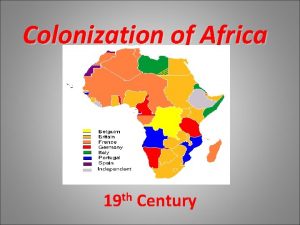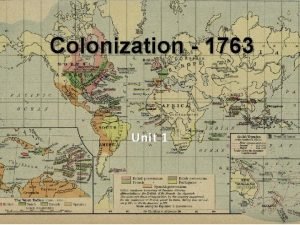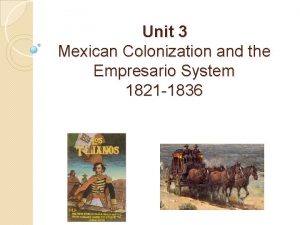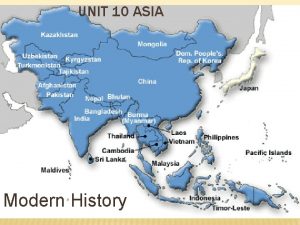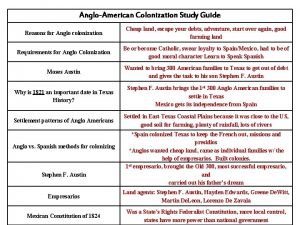The English literature of colonization 1 The literature
















- Slides: 16

The English literature of colonization ( 1. The literature of exploration

• First written manifestations: chronicles of travellers and early colonizers • A Brief and True Report of the New Found Land of Virginia (1588), by Thomas Harriot • A True Relation of Virginia (1608), A Map of Virginia (1612) and The General History of Virginia, New England the Summer Isles (1624), by John Smith

Characteristics • Geographical accounts of the new found lands • The intention was to inform readers about the colonial enterprise in the New World. • Virginia was their first destination, and profit was their main motivation. • Chronicles have historical interest. They provide data about the history of colonisation

• Early chronicles relate facts such as… • 1605: first abortive attempt to establish an English settlement (in what is now Maine) • 1607: first permanent English settlement, called Jamestown, Virginia, founded by the London Company. • The settlers chose a location close to the water, hoping to establish a thriving community.

JAMESTOWN

• Disaster dogged the first Virginians for 20 years (starvation, plagues, diseases, quarrels with the Indians…). By the end of 1607 only 38 men survived of the hundred who had landed

• On colonial chronicles: • Many were not objective • Accounts used the language of European conventions, in particular the idyllic vision of America as unspoiled wilderness • Major images from classical sources and Renaissance literature: America as Arcadia, as bountiful natural, and from the Bible: America as the Garden of Eden

• An exception: Captain John Smith did not exaggerate the possibilities for wealth • His motto was “work or starve” (only the hardworking would survive and succeed) • Otherwise, he stretched the truth of his stories • His tale about his relationship with the Indian princess Pocahontas is the most famous one

The Native Population

• When the Europeans arrived, the land was already inhabited by different tribes • Native-Americans did not yield easily to the newcomers • Issues of ownership and land occupation became areas of conflict: agriculture (tobacco) versus hunting • Native Americans began to fight this encroachment


The Indians in the Eyes of the Europeans • Native Americans had a rich oral literature, but no written literature among the more than 500 tribes • The fact that the native population did not have a system of writing was perceived as a sign of their inferiority • This reinforced the idea that America was meant for the Europeans

Images of the native population in the Americas in the 16 th century • Indians perceived as inferior men • Indians cast in the role of women • “Indians should honor, obey, fear and love us” (Thomas Harriot)

Images of Native Americans in the 17 th century • In later accounts, the continent is “empty”: Indian presence is ignored, making the natives as only one aspect of the inhuman wilderness • The myth that America was “empty” has been perpetuated in contemporary cultural histories of USA: Henry Nash Smith’s vision of the West in Virgin Land (1979)

Implications of early images of Native Americans • The idea of America as “empty” space justified European’s view that God had created America so that Europeans could expand their civilization • The concept of “Manifest Destiny”, articulated in the 19 th century, is crucial in the history of USA

Manifest Destiny www. csub. edu/~gsantos/cat 16. html
 Spanish colonization of the americas
Spanish colonization of the americas Reason for colonization
Reason for colonization Colonization of south america
Colonization of south america Who colonized north america
Who colonized north america Cycle of conquest and colonization
Cycle of conquest and colonization Colonization
Colonization Colonization
Colonization Early european exploration and colonization resulted in
Early european exploration and colonization resulted in Why did western nations desire lands in the pacific rim?
Why did western nations desire lands in the pacific rim? God gold glory
God gold glory Wilson whap
Wilson whap Mexican colonization and the empresario system
Mexican colonization and the empresario system Unit 2: exploration and georgia colonization
Unit 2: exploration and georgia colonization Colonization acrostic poem
Colonization acrostic poem Cocciq
Cocciq Colonization defenition
Colonization defenition Space colonization
Space colonization




